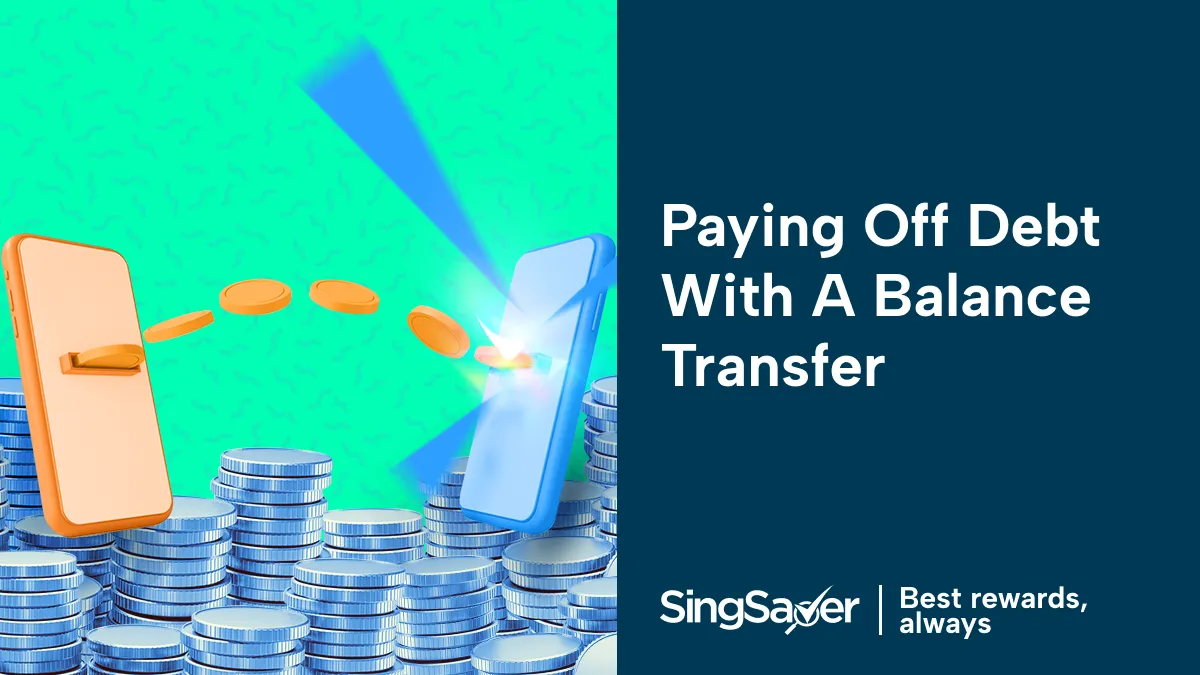Balance Transfer: What Is It And Should You Consider It?
Updated: 11 Apr 2025
Balance transfers can be a strategic move to manage your credit card debt. By transferring your outstanding balance from a high-interest card to one with a lower interest rate, especially during a promotional period, you could potentially save on interest charges. However, it's crucial to compare the Effective Interest Rates (EIRs) and any associated fees to ensure the transfer truly benefits your financial goals.
Written bySingSaver Team
Team

The information on this page is for educational and informational purposes only and should not be considered financial or investment advice. While we review and compare financial products to help you find the best options, we do not provide personalised recommendations or investment advisory services. Always do your own research or consult a licensed financial professional before making any financial decisions.
What is a balance transfer?
A balance transfer is a type of unsecured, short-term 0% or low-interest loan commonly offered on a credit card or credit line account.
As its name suggests, it lets you transfer either the outstanding balance on your credit card(s) to another credit card or a percentage of your available credit card limit to your deposit account to enjoy a low or 0% interest rate loan for a specific period ranging from 3 to 12 months. The balance transfer amount that you borrow will be deposited into a bank account.
SingSaver Personal Loans Cashback Offer
Enjoy interest rates as low as 1.48% p.a. (EIR from 2.84% p.a.) and up to S$1,900 in cashback when you apply for a personal loan via SingSaver. Valid till 1 February 2026. T&Cs apply.
Who should consider a balance transfer?
A balance transfer can be an excellent option for individuals with high-interest credit card debt who want to pay it off faster and at a lower cost. It is especially beneficial for those struggling to manage multiple credit card balances.
If you're juggling several outstanding balances across different cards, a balance transfer can be helpful. It allows you to consolidate your debt into one manageable payment, often at a lower interest rate or even 0% EIR for a limited period. This can help you save on interest payments, enabling you to focus on paying down the principal faster.
For people who are having difficulty paying off their credit card debt, a balance transfer can provide much-needed relief. You can reduce the amount of money spent on interest by transferring your debt to a card with a lower interest rate, giving you more room to make progress on clearing the debt itself.
However, it’s essential to ensure that you can pay off the balance within the interest-free or promotional period. If you are unable to clear your balance before the interest-free period ends, you risk being hit with a high interest rate, which can be as high as 26.9% p.a. This could undo all the benefits of the balance transfer and bring you right back to where you started, with even more debt.
Therefore, a balance transfer is only a good option if you're confident that you can pay off the debt within the promotional period. For those who can manage this, a balance transfer can offer a strategic way to regain control over their finances and pay off debt more efficiently.
|
Saver-savvy tip Where might people encounter issues with a balance transfer? |
|
People may face issues with a balance transfer if they don't account for the balance transfer fee, which could reduce the overall savings. It’s essential to evaluate whether the fee is worth it compared to the interest you would pay on your current card. Additionally, without a solid plan—like addressing spending habits, building an emergency fund, and using debit or cash instead of credit—it can be harder to make significant progress in paying off the balance. |
|
Balance transfer credit cards can be effective tools for managing debt by potentially reducing interest payments. However, it's crucial to actively oversee your debt and adhere to a structured repayment plan. Missing a payment could lead to the loss of your introductory interest-free period and decrease your credit score. |
|
Many people who plan to do a balance transfer are often surprised and disappointed when their credit limit is lower than expected, preventing them from transferring all their debt. For example, you might have S$20,000 in debt you want to move, but only be approved to transfer S$3,000. |
Unlock the power of balance transfers.
A balance transfer can be an effective way to manage high-interest credit card debt, but choosing the right card is crucial. Explore a list of the best balance transfer credit cards in Singapore to find the options that offer the lowest fees and the most favourable terms. Check out our comprehensive comparison pages to make an informed decision and start saving today!
Who is eligible for a balance transfer?
In Singapore, balance transfer eligibility is determined by various financial institutions, each setting specific criteria to ensure applicants can responsibly manage the debt being transferred. Key factors influencing eligibility include age, income, existing banking relationships, credit limits, and credit scores.
-
Age requirements: Most banks in Singapore require applicants to be at least 21 years old to be eligible for balance transfer services.
-
Income requirements: A stable income is crucial for balance transfer eligibility. Minimum annual income requirements vary among banks:
-
-
Singapore citizens and permanent residents: Typically, a minimum annual income of S$30,000 to S$50,000 is required.
-
Foreign applicants: Banks often set higher income thresholds, with minimum annual incomes starting from S$45,000.
-
-
Existing banking relationships: Having an existing relationship with a bank can influence your balance transfer application. Some banks offer preferential rates or easier approval processes for current customers. It's worth exploring options with banks where you already hold accounts.
-
Credit Limits: The credit limit on your existing credit card affects your eligibility for a balance transfer. Banks may allow you to transfer up to a certain percentage of your available credit limit, often up to 95%. For example, if your available credit limit is S$10,000, the maximum balance transfer amount may be S$9,500.
-
Credit Score: Your credit score plays a crucial role in balance transfer applications. A good credit score increases your chances of approval and may lead to better balance transfer offers. Banks generally look for scores above 1,000 on the Singapore Credit Bureau scale.
Please note: Balance transfers are typically not permitted between credit cards issued by the same bank. For example, debts on a Citibank card cannot be transferred to another Citibank card, such as the Citi Simplicity® Card. Similarly, Standard Chartered credit card funds transfer facility does not allow balance transfers between its own credit cards.
>> More: Balance transfer comparison: Citibank vs Standard Chartered.
How to apply for a balance transfer in Singapore?
Applying for a balance transfer in Singapore can help you manage your credit card debts more effectively by consolidating them into a single account with a lower interest rate. Here's a step-by-step guide to assist you:
-
Choose a suitable balance transfer card: Research various banks and credit card providers to find a balance transfer credit card that offers favourable terms, such as a 0% introductory interest rate for a specific period and low processing fees. For example, Standard Chartered offers a 0% interest rate with a processing fee starting from 1.80% for a 12-month tenure.
-
Apply for the balance transfer card: Visit the chosen bank's website or branch to apply for the balance transfer card. You'll need to provide personal and financial information, including your annual income, which typically ranges from S$30,000 to S$50,000 for Singaporeans and Permanent Residents.
-
Request the balance transfer: Once approved, log in to your new account via the bank's digital banking platform. Navigate to the balance transfer section and provide details of your existing credit card debts, including account numbers and outstanding amounts. Specify the amount you wish to transfer, keeping in mind any credit limits imposed by the bank.
-
Review processing times and fees: Understand the processing time, which can vary by bank. For instance, Standard Chartered disburses funds instantly into your account or within 15 minutes to another bank's account. Be aware of the processing fees, which are usually calculated as a percentage of the loan principal.
-
Ensure timely payments: After the balance transfer, make sure to meet the minimum payment requirements each month. Missing payments can result in penalties and the reversion of interest rates to higher standard rates.
Saver-savvy tip
Credit card debt isn’t the only debt you can transfer. Many banks also let cardholders transfer other debts, like auto loans or personal loans, to a credit card.
What is the savings potential of a balance transfer?
A balance transfer in Singapore allows you to consolidate existing credit card debts onto a new card with a 0% introductory interest rate for a specified period, potentially leading to significant savings.
For example, CIMB offers a 0% interest rate for a 3-month balance transfer with a 1.6% processing fee; transferring S$10,000 under these terms could save about S$535 in interest compared to a standard rate of 27.8% per annum.
While the precise savings from a balance transfer depend on your individual circumstances, including your current debt, interest rates, and repayment plan, our balance transfer calculator can provide valuable insights.
How to select the right balance transfer card?
Selecting the right balance transfer card in Singapore requires assessing certain factors to make sure it aligns with your financial goals. Here's how you can make an informed choice:
-
Compare interest rates and promotional periods: Look for cards offering low or 0% interest rates during the promotional period. Longer promotional periods provide more time to repay without incurring interest. For example, Standard Chartered offers a 0% interest rate for the duration of the approved tenure with a processing fee of 1.8% to up to 4.5%.
-
Evaluate processing fees: Processing fees can significantly impact your overall savings. Compare fees across different cards to find the most cost-effective option. For instance, CIMB provides a 0% interest rate with flexible repayment options and low processing fees, making it an attractive choice for balance transfers.
-
Consider annual fees: Opt for cards without annual fees to maximize your savings. Review the card's terms to ensure there are no hidden costs that could offset the benefits of the balance transfer.
-
Assess repayment terms: Choose a card that offers flexible repayment periods that match your financial conditions. For example, DBS provides 0% interest over 3, 6, or 12 months, allowing you to select a tenure that aligns with your repayment capacity.
-
Review eligibility requirements: Make sure you comply with the eligibility criteria, such as credit score considerations and minimum income requirements, regarding the balance transfer card. This step is crucial to avoid application rejections or unfavourable terms.
-
Use comparison tools: Use online comparison tools and calculators to evaluate different balance transfer offers.
-
Read reviews and seek recommendations: Reading reviews and searching for recommendations can provide insights into the experiences of other users. This will help you make a more informed decision.
Is a balance transfer the right option for you?
Deciding between a balance transfer and other debt management options, such as personal loans, depends on your financial situation. Balance transfers typically offer a 0% interest rate for a promotional period, allowing you to save on interest, but you must pay off the debt before the promo ends. If the balance isn't cleared in time, high-interest rates may apply, sometimes as much as 30% per annum.
On the other hand, personal loans offer fixed interest rates and longer repayment periods, one to seven years, providing more predictable monthly payments. If you're considering a personal loan, you may also pre-qualify for a personal loan before committing. Personal loans often come with higher interest rates (3.5% to 10.8% per annum) and processing fees, making them more expensive in the long run.
When choosing between the two, assess whether you can repay the transferred balance within the promotional period and consider the risks of post-promo rates. Evaluate the total cost, including interest and fees, to make an informed decision that aligns with your repayment capacity.
>> More: Learn more about balance transfer.
Discover the perfect balance transfer credit card for you.
Whether you're looking to save on interest or earn more rewards, the ideal balance transfer credit card is waiting for you. Explore the best options and make the right choice.
Stay ahead in everything finance
Subscribe to our newsletter and receive insightful articles, exclusive tips, and the latest financial news, delivered straight to your inbox.
About the author
SingSaver Team
At SingSaver, we make personal finance accessible with easy to understand personal finance reads, tools and money hacks that simplify all of life’s financial decisions for you.



